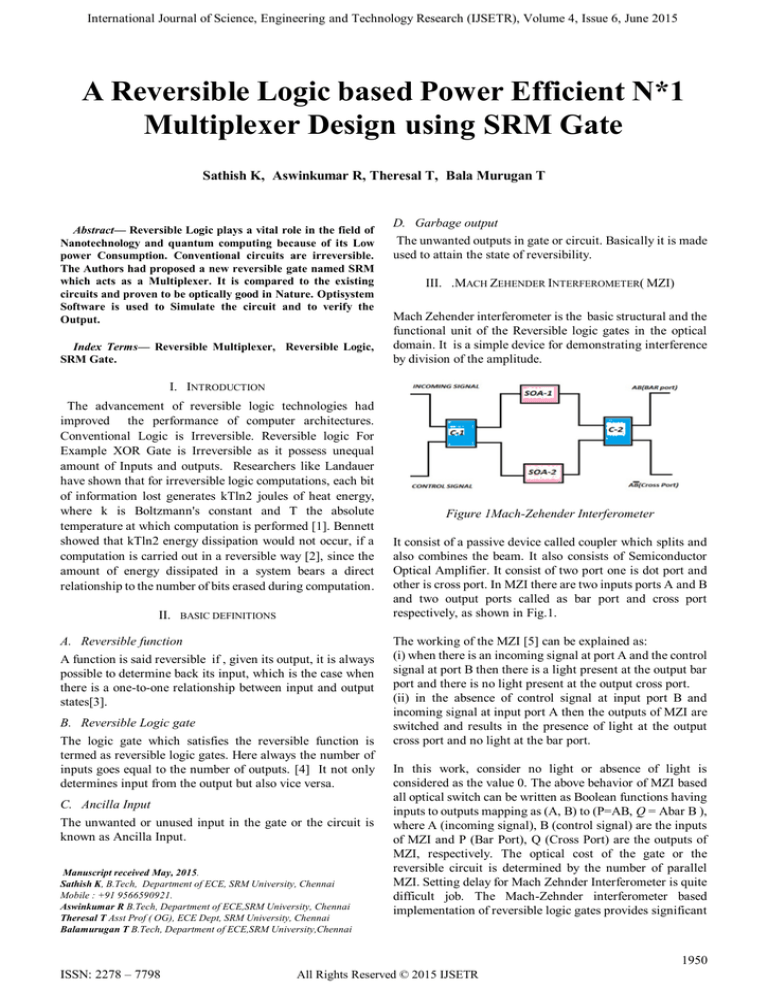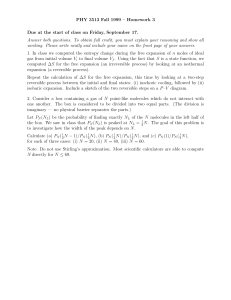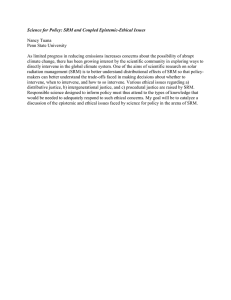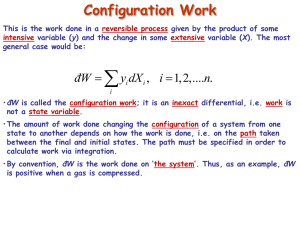
International Journal of Science, Engineering and Technology Research (IJSETR), Volume 4, Issue 6, June 2015
A Reversible Logic based Power Efficient N*1
Multiplexer Design using SRM Gate
Sathish K, Aswinkumar R, Theresal T, Bala Murugan T
Abstract— Reversible Logic plays a vital role in the field of
Nanotechnology and quantum computing because of its Low
power Consumption. Conventional circuits are irreversible.
The Authors had proposed a new reversible gate named SRM
which acts as a Multiplexer. It is compared to the existing
circuits and proven to be optically good in Nature. Optisystem
Software is used to Simulate the circuit and to verify the
Output.
Index Terms— Reversible Multiplexer, Reversible Logic,
SRM Gate.
D. Garbage output
The unwanted outputs in gate or circuit. Basically it is made
used to attain the state of reversibility.
III. .MACH ZEHENDER INTERFEROMETER( MZI)
Mach Zehender interferometer is the basic structural and the
functional unit of the Reversible logic gates in the optical
domain. It is a simple device for demonstrating interference
by division of the amplitude.
I. INTRODUCTION
The advancement of reversible logic technologies had
improved the performance of computer architectures.
Conventional Logic is Irreversible. Reversible logic For
Example XOR Gate is Irreversible as it possess unequal
amount of Inputs and outputs. Researchers like Landauer
have shown that for irreversible logic computations, each bit
of information lost generates kTln2 joules of heat energy,
where k is Boltzmann's constant and T the absolute
temperature at which computation is performed [1]. Bennett
showed that kTln2 energy dissipation would not occur, if a
computation is carried out in a reversible way [2], since the
amount of energy dissipated in a system bears a direct
relationship to the number of bits erased during computation.
II.
BASIC DEFINITIONS
A. Reversible function
A function is said reversible if , given its output, it is always
possible to determine back its input, which is the case when
there is a one-to-one relationship between input and output
states[3].
B. Reversible Logic gate
The logic gate which satisfies the reversible function is
termed as reversible logic gates. Here always the number of
inputs goes equal to the number of outputs. [4] It not only
determines input from the output but also vice versa.
C. Ancilla Input
The unwanted or unused input in the gate or the circuit is
known as Ancilla Input.
Manuscript received May, 2015.
Sathish K, B.Tech, Department of ECE, SRM University, Chennai
Mobile : +91 9566590921.
Aswinkumar R B.Tech, Department of ECE,SRM University, Chennai
Theresal T Asst Prof ( OG), ECE Dept, SRM University, Chennai
Balamurugan T B.Tech, Department of ECE,SRM University,Chennai
Figure 1Mach-Zehender Interferometer
It consist of a passive device called coupler which splits and
also combines the beam. It also consists of Semiconductor
Optical Amplifier. It consist of two port one is dot port and
other is cross port. In MZI there are two inputs ports A and B
and two output ports called as bar port and cross port
respectively, as shown in Fig.1.
The working of the MZI [5] can be explained as:
(i) when there is an incoming signal at port A and the control
signal at port B then there is a light present at the output bar
port and there is no light present at the output cross port.
(ii) in the absence of control signal at input port B and
incoming signal at input port A then the outputs of MZI are
switched and results in the presence of light at the output
cross port and no light at the bar port.
In this work, consider no light or absence of light is
considered as the value 0. The above behavior of MZI based
all optical switch can be written as Boolean functions having
inputs to outputs mapping as (A, B) to (P=AB, Q = Abar B ),
where A (incoming signal), B (control signal) are the inputs
of MZI and P (Bar Port), Q (Cross Port) are the outputs of
MZI, respectively. The optical cost of the gate or the
reversible circuit is determined by the number of parallel
MZI. Setting delay for Mach Zehnder Interferometer is quite
difficult job. The Mach-Zehnder interferometer based
implementation of reversible logic gates provides significant
1950
ISSN: 2278 – 7798
All Rights Reserved © 2015 IJSETR
International Journal of Science, Engineering and Technology Research (IJSETR), Volume 4, Issue 6, June 2015
advantages such as high speed, low power, fast switching
time, and ease in the fabrication.
IV. PROPOSED WORK
A. The Proposed SRM GATE
The inputs and the outputs of the proposed 3*3 reversible
SRM Gate are A,B,C and P,Q,R respectively.
The simple block diagram of the proposed SRM Gate is
shown in the figure 2.
The Optical implementation of the proposed SRM gate
preferred for the 2*1 Multiplexer is given in the figure 3.The
Optical Implementation requires the Beam Splitter, Beam
Combiner and the Mach Zehender Interferomter. The
designed circuit can be implemented or simulated using the
Optisystem Software.
V. N*1 MULTIPLEXER USING SRM GATE
The N*1 Multiplexer can be designed using the proposed
Reversible SRM Gate. The proposed Reversible Logic SRM
Gate itself represents as the 2*1 Multiplexer.
A.4*1 Multiplexer using 2*1 Multiplexer
Figure 2 Block Diagram of the Proposed SRM Gate
B Truth Table of the Proposed SRM Gate
The truth table of the Proposed SRM Gate is given in the
table 1.
A
0
0
0
0
1
1
1
1
INPUTS
B
C
0
0
0
1
1
0
1
1
0
0
0
1
1
0
1
1
OUTPUTS
P
Q
R
0
0
0
1
0
0
0
1
0
1
1
1
0
1
1
1
1
0
0
0
1
1
0
1
Figure 4 Block Diagram of the 4*1 MUX Proposed SRM
Gate
Three SRM Gates are required to make the 4*1 Multiplexer.
3 SRM Gates are required to make the 4*1 Multiplexer. It
consists of 4 ancilla inputs and 5 garbage outputs. Figure 5
represents the Reversible 4*1 Multiplexer using the 2*1
Multiplexer.
Table 1 Truth Table of the Proposed SRM Gate
B. 16*1 Multiplexer using 4*1 Multiplexer
C. Optical Implementation
Figure 3 Optical Implementation of the Proposed SRM Gate
Figure 5 Block Diagram of the 16*1 MUX Proposed SRM
Gate
1951
ISSN: 2278 – 7798
All Rights Reserved © 2015 IJSETR
International Journal of Science, Engineering and Technology Research (IJSETR), Volume 4, Issue 6, June 2015
15 SRM Gates are required to make the 16*1 Multiplexer. It
consists of 20 ancilla inputs and 10 garbage outputs. Figure 5
represents the Reversible 16*1 Multiplexer using the 4*1
Multiplexer.
Similarly we can design any no. of Input to Single Output
Multiplexer using the proposed SRM gate
VI.
CIRCUIT SIMULATION
The circuit is simulated using Optisystem Sofware
Chart 1 Comparison based on Entity
B. Comparative Chart with respect to Existing Multiplexer
[7]
Comparing with Optical Implementation SRM
Multiplexer With the Existing One in terms of its No. of
Power splitters, Power Combiners ,Inputs, Outputs etc .
Existing
SRM
6
If the inputs are A=01010101 and B=00101010 then for the
two cases of the control.
4
2
Case 1: If C=0 then SRM Gate selects the input A
0
Splitter
Combiner
Input
Output
Chart 2 Comparison based on Optical Implementation
.
Case 2: If C=1 then SRM Gate selects the input B
VIII.
CONCLUSION
In this paper, the Reversible SRM Gate is proposed for the
improvised and the efficient performance of the Multiplexer.
One of the major constrains in the reversible Logic to reduce
the number of the gates. This is achieved for the Multiplexer
through the proposed SRM Gate.
VII.
ACKNOWLEDGMENT
COMPARISON
The proposed Reversible SRM Multiplexer is more efficient
than the existing Multiplexers. The following Comparative
Chart clearly proves SRM Multiplexers Efficiency.
A. Comparative Chart with respect to Existing Multiplexer
[6]
Comparing the SRM Multiplexer With the Existing One
in terms of its Ancilla Inputs, Garbage Outputs, Optical Cost
and the Gate Count.
The authors wish to thank the Department of Electronics and
Communication Engineering, SRM University, Chennai for
their constant help and support to complete the project.
Hereby the authors wish to thank their parents for their
continuous encouragement and the support.
REFERENCES
[1]
[2]
[3]
R. Landauer, “Irreversibility and heat generation in the computing
process,”IBM J. Res. Develop., vol. 3, pp. 183–191, 1961.
Bennett, C.H., “Logical reversibility of Computation”, IBM J.Research
and Development, 17: pp. 525-532, 1973.
B.Raghu kanth, B.Murali Krishna, M. Sridhar, V.G. Santhi Swaroop ―A
DISTINGUISH BETWEEN REVERSIBLE AND CONVENTIONAL
1952
ISSN: 2278 – 7798
All Rights Reserved © 2015 IJSETR
International Journal of Science, Engineering and Technology Research (IJSETR), Volume 4, Issue 6, June 2015
[4]
[5]
[6]
[7]
LOGIC GATES ‖, International Journal of Engineering Research and
Applications (IJERA) ISSN: 2248-9622 www.ijera.com Vol. 2, Issue
2,Mar-Apr 2012, pp.148-151
Hafiz Md. Hasan babu, Md. Rafiqu Islam, Ahsan Raja Chowdhary and
Syed Mostahead Ali chowdhary “ Reversible logic synthesis for
minimization of full adder ckt”, IEEE conference on Digital system
design 2003,Enro-micro‟03, Belek,Antalya,Tarkey,2003,PP 50-54.
C. Taraphdara, T. Chattopadhyay, and J. Roy, “Mach-zehnder
interferometer-based all-optical reversible logic gate,” Optics and Laser
Technology, vol. 42, no. 2, pp. 249–259, 2010
Goutam Kumar Maity,Tanay Chattopadhay,Jitendra Nath Roy and Santi
Prasad
Maity,
“ALL
OPTICAL
REVERSIBLE
MULTIPLEXER”,2009 International Conference on Comuters and
Devices for Communication.
Rohan Katti,Shanthi Prince, “Implementation of a Reversible All Optical
Multiplexer
Using
Mach-Zehender
Interferometer”
IEEE
978-1-4799-1823-2/15.
AUTHORS
Sathish K is persuing his B.Tech degree under the department of ECE in SRM
University. He had published a paper in named A NEW DESIGN OF
OPTICAL REVERSIBLE ADDER AND SUBTRACTOR USING MZI He
also published a paper named AN OPTIMIZED IMPLEMENTATION OF
ALL REVERSIBLE LOGIC GATES USING NEWLY DESIGNED ALL
GATE. . He is currently working on a project towards „ REVERSIBLE ALU‟.
Aswinkumar R is persuing his B.Tech degree under the department of ECE in
SRM University. He had published a paper in named A NEW DESIGN OF
OPTICAL REVERSIBLE ADDER AND SUBTRACTOR USING MZI He
also published a paper named AN OPTIMIZED IMPLEMENTATION OF
ALL REVERSIBLE LOGIC GATES USING NEWLY DESIGNED ALL
GATE. . He is currently working on a project towards „ REVERSIBLE ALU‟.
Theresal T is an Asst Prof (OG) in SRM University. She obtained B.E Degree
in Xaviers Catholic College of Engineering and PG in A.C. Tech, Karaikudi.
She has Presented Paper in Third IEEE International Conference on
Communication and signal Processing titled on All Optical Basic Gates and
XOR Gate Using SOA Based MZI and Presented Paper in Third IEEE
International Conference on Communication and signal Processing titled on
Design All Optical Reversible Logic Gates. Rakesh.P ,Theresal.T, published a
paper on ”Intellectual Power Generation Through Solar Energy”,IJRIT”issue
no-2,volume no -2,April 2014. She is currently working on a project towards „
REVERSIBLE ALU‟.
Bala Murugan T is persuing his B.Tech degree under the Department of
Electronics & Communication Engineering in SRM University.He is currently
working towards the „REVERSIBLE ALU‟
1953
ISSN: 2278 – 7798
All Rights Reserved © 2015 IJSETR




